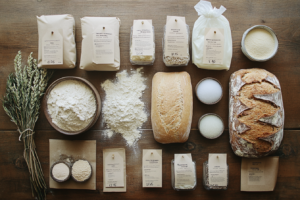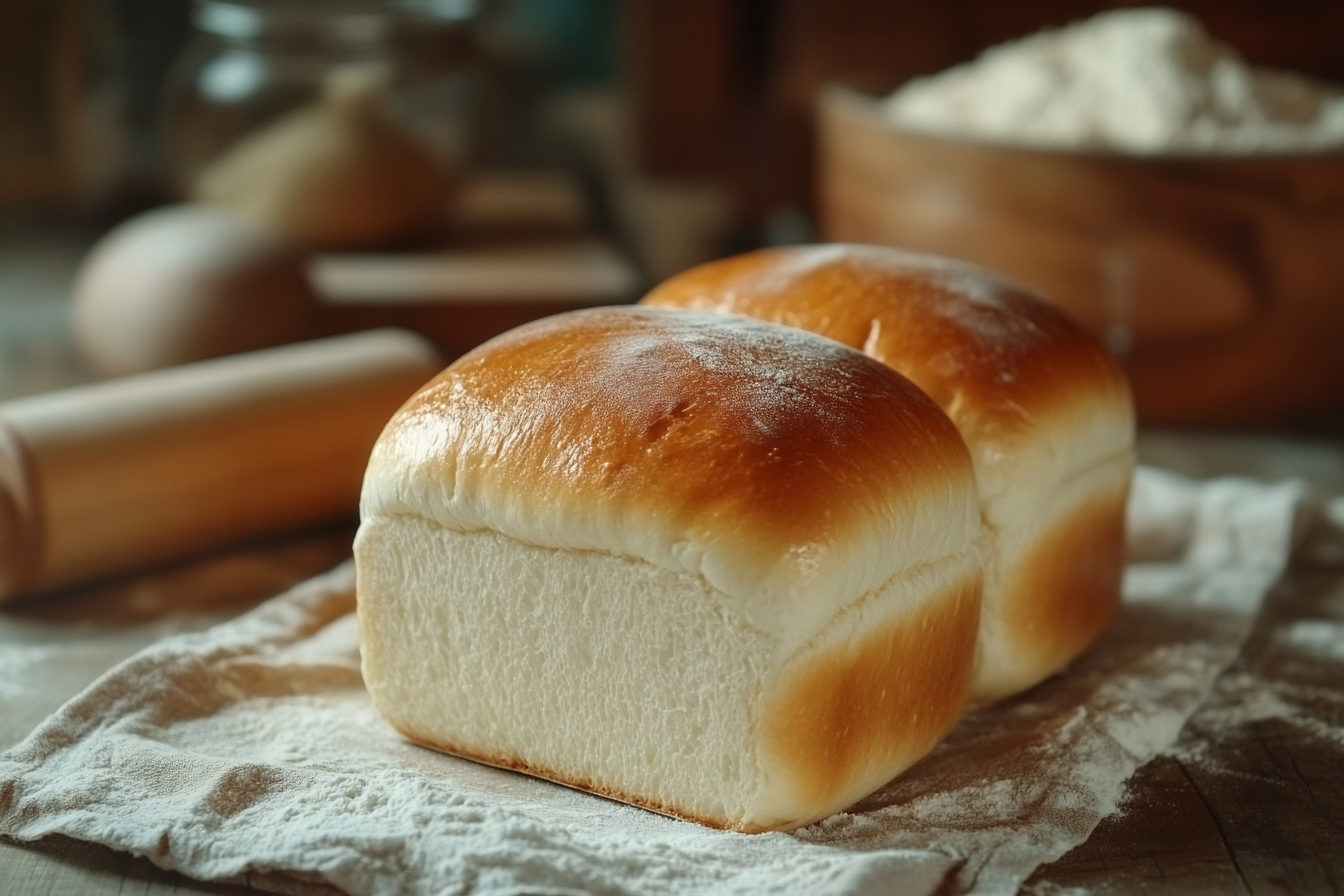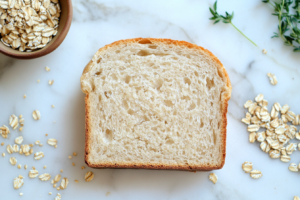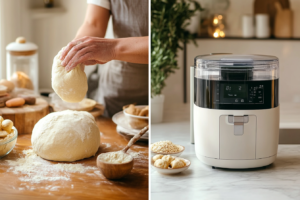Introduction
Is it cheaper to make your own sandwich bread? With grocery costs rising and more people turning to home cooking, many wonder if homemade bread is the more cost-effective choice. Making your own sandwich bread not only has the potential to save money but is often fresher, tastier, and potentially healthier than store-bought options. But just how much can you save? In this article, we’ll dive into the costs of homemade sandwich bread, comparing them to store-bought options. We’ll also examine the time commitment, health benefits, and the necessary tools to help you decide if making your own bread is worth the effort.
Let’s get started with an analysis of ingredient costs, which is where every homemade loaf begins!
Cost Analysis: Is It Cheaper to Make Your Own Sandwich Bread?
Breakdown of Ingredients for Making Your Own Sandwich Bread

When you make bread at home, the main ingredients you’ll use are simple: flour, yeast, salt, sugar, and water. These ingredients can be bought in bulk, which can lower the cost per loaf. But what does each ingredient actually cost? Here’s a breakdown:
- Flour: The backbone of any bread, flour typically costs between $0.50 and $1.00 per pound, depending on the brand and type. A loaf of sandwich bread might need around 3-4 cups, which is about 1 pound of flour.
- Yeast: Yeast is essential for making the bread rise and giving it that airy texture. Active dry yeast can cost around $0.50 to $1.00 per ounce, with a loaf usually requiring a teaspoon or so. Buying yeast in bulk can cut costs significantly.
- Salt and Sugar: These minor ingredients may seem negligible in cost, but they do add flavor and help the bread rise properly. Each adds only a few cents to the overall price.
- Water: Practically free from the tap, water doesn’t add much to the cost but is, of course, essential to the recipe.
In total, a homemade loaf of sandwich bread usually costs around $1 to $1.50 for ingredients alone, depending on quality and the brands you choose. This is quite a savings compared to many store-bought breads, especially higher-quality or artisan brands, which can range from $3 to $5 per loaf.
Comparing Store-Bought Bread to Homemade Sandwich Bread Costs.
Store-bought bread comes with its conveniences, but it also comes with its own price range. On the lower end, generic brands may only cost $1 or $2, while higher-end, organic, or preservative-free varieties can easily cost up to $5 or more. Comparing store-bought to homemade, it’s clear that making bread at home can save you a few dollars per loaf, especially if you prefer premium bread.
However, keep in mind that store-bought bread has preservatives that can keep it fresh for days or even weeks. Homemade bread, on the other hand, will generally last a few days before it begins to harden, requiring you to bake more frequently if you want a steady supply.
Initial Costs: Tools & Equipment for Homemade Bread
If you’re planning to bake regularly, you’ll need some basic equipment, which may involve an upfront investment. Let’s look at what you need:
- Mixing Bowls and Bread Pans: Basic tools like a mixing bowl and a loaf pan are affordable, typically around $10-$20 each. If you bake often, these items will quickly pay for themselves.
- Bread Machine or Stand Mixer: A bread machine simplifies the process, allowing you to make bread with minimal effort. Machines can range from $50 to $300, depending on features, while a stand mixer (with a dough hook) can cost between $100 and $500. Though these are optional, they make bread-making easier and might be a worthy investment if you plan to bake frequently.
In summary, the initial costs of equipment might seem like a hurdle. However, if you bake regularly, this investment can be recouped quickly compared to the cost of buying store-bought bread long-term.
Time Commitment
How Long Does It Take to Make Your Own Sandwich Bread?
Making bread from scratch is a labor of love, but it can also be time-consuming. Bread-making involves several stages, each requiring a different amount of time and attention. Here’s a breakdown of the time commitment involved in preparing a loaf of homemade sandwich bread:
- Mixing Ingredients: This step is straightforward and takes about 10-15 minutes. If you’re using a bread machine or stand mixer, this can be even quicker, as the machine handles most of the mixing for you.
- Kneading the Dough: Kneading is essential to develop gluten in the dough, which gives the bread its structure. By hand, this step can take 10-15 minutes, but using a mixer with a dough hook can reduce it to just 5-10 minutes.
- First Rise (Proofing): After kneading, the dough needs to rise. This is a passive step, but it typically takes 1-2 hours, depending on room temperature and the type of yeast used. During this time, you can go about other tasks, but it’s a waiting game.
- Shaping and Second Rise: Once the first rise is complete, you’ll shape the dough into a loaf and let it rise a second time, which usually takes 30 minutes to an hour.
- Baking the Bread: Baking usually takes about 25-30 minutes in a preheated oven. Once out, the bread should cool for another 15-20 minutes to reach an ideal slicing temperature.
In total, making bread from scratch can take around 3-4 hours, though much of that time is passive. If you’re using a bread machine, it can automate much of this process, meaning you don’t need to be actively involved after setting it up. However, for those following the traditional method, making bread does require a significant time commitment.
s Making Your Own Sandwich Bread Worth the Time Investment?
Time is precious, and deciding if homemade bread is worth your time investment depends on your lifestyle and priorities. For many people, the appeal of baking bread isn’t just about saving money but also about the quality and satisfaction of creating something from scratch. Here’s a quick look at the pros and cons of time investment:
- Pros: Baking your own bread gives you full control over the ingredients, ensuring you know exactly what’s in each loaf. Additionally, the taste and freshness of homemade bread are hard to beat.
- Cons: The time commitment is significant, especially if you’re making bread several times a week. While a bread machine can help streamline the process, it still requires planning and prep.
For those who value freshness, health benefits, and the satisfaction of making food at home, investing time in homemade bread can be highly rewarding. But if you’re looking primarily for convenience, the time commitment may outweigh the benefits.
Next, we’ll explore the health benefits of homemade bread, which can play a big role in deciding if homemade bread is worth the effort.
Health & Quality Benefits of Making Your Own Sandwich Bread.
Nutritional Advantages of Homemade Sandwich Bread
When you make your own sandwich bread, you control the ingredients, making it fresher and healthier than most store-bought options. One of the biggest advantages of homemade bread is the control it gives you over ingredients. Here’s how homemade bread stands out nutritionally:
- Fewer Additives and Preservatives: Store-bought bread often contains preservatives to extend shelf life, along with additives that enhance texture and flavor. When you make bread at home, you avoid these additives, resulting in a cleaner product. Plus, without preservatives, homemade bread is fresher and more natural.
- Reduced Sugar and Sodium: Many commercially made breads contain higher levels of sugar and salt for flavor. With homemade bread, you can adjust these ingredients to meet your health preferences, reducing unnecessary sugar and sodium intake.
- Healthier Ingredient Choices: By making bread at home, you can use higher-quality ingredients, such as whole grains or organic flour, which can add fiber, nutrients, and flavor to your bread. Additionally, you can experiment with adding seeds, nuts, or other nutrient-rich ingredients that are less common in store-bought bread.
Taste and Texture: Homemade vs. Store-Bought Bread
Let’s be honest – the taste of homemade bread often can’t be matched by store-bought alternatives. Here’s why:
- Freshness: Since homemade bread doesn’t contain preservatives, it’s usually baked and eaten within a few days, delivering a freshness that’s hard to find in store-bought options. This freshness greatly impacts taste and texture, making each bite softer and more flavorful.
- Texture Control: Depending on how you bake it, homemade bread can have a wonderfully chewy, airy texture or a dense, hearty feel. You can experiment with different methods to achieve your preferred texture, which is often not possible with store-bought varieties.
Customizing Your Bread for Health Preferences
One of the greatest advantages of making bread at home is that you can tailor it to your dietary needs. Whether you’re gluten-free, vegan, or looking to cut down on sugar, homemade bread allows you to make specific choices that fit your lifestyle. Here are some customization ideas:
- Gluten-Free Bread: For those with gluten sensitivities, making gluten-free bread at home ensures it meets your dietary requirements, which can be difficult to find in stores.
- Low-Sugar or Low-Sodium Bread: As mentioned, homemade bread can be customized to reduce sugar and salt, making it a healthier option.
- Whole Grains and Fiber: Adding whole wheat flour, oats, chia seeds, or flaxseeds to your bread increases fiber and nutrient content, which contributes to digestive health and a fuller feeling after eating.
Making bread at home not only improves nutritional value but also allows you to make something unique and personalized to your taste and health goals. For many, this level of customization is a key reason to make bread at home rather than buy it.
Bread-Making Methods & Tips
Traditional Method vs. Bread Machine: Making Your Own Sandwich Bread
If you’re exploring homemade bread options, you’ve likely come across two primary methods: the traditional hand-kneading method and using a bread machine. Each method has its own pros and cons in terms of cost and convenience.
- Traditional Method: This method involves mixing, kneading, proofing, and baking by hand or with minimal tools. It allows for greater control over each step, which many people find enjoyable and therapeutic. The downside is the time and effort required. Kneading dough by hand and waiting for it to rise can be a slow process, but for those who enjoy hands-on cooking, the traditional method can be highly satisfying.
- Bread Machine Method: A bread machine automates the entire process, from mixing and kneading to baking, with minimal hands-on time. Just add ingredients, set the machine, and let it do the work. Bread machines vary in price, from about $50 for basic models to over $300 for advanced ones. For busy individuals, a bread machine can be a worthy investment, saving time and reducing the effort involved.
For cost savings, both methods can be effective, but the bread machine offers significant convenience. If you plan to bake frequently and prefer a hands-off approach, the machine might be your best bet. However, if you enjoy a hands-on experience and have the time, the traditional method offers a deeper connection to the bread-making process.
Tips for Reducing Costs When Making Bread
Making bread at home can be economical, especially with a few smart strategies to reduce ingredient costs and make the most of your resources. Here are some tips to make homemade bread even cheaper:
- Buy Ingredients in Bulk: Purchasing flour, yeast, and salt in larger quantities can reduce costs over time. Wholesale clubs or bulk sections at grocery stores often offer significant savings, especially for essential items like flour and yeast.
- Choose Simple Ingredients: For basic sandwich bread, you don’t need expensive ingredients. Stick with all-purpose flour, tap water, and a simple yeast package to keep costs low.
- Reuse Tools and Equipment: If you plan on making bread regularly, investing in durable, reusable items like a good loaf pan and quality mixing bowls will save money over time. Avoid disposable items and instead, choose items that will last and simplify the process.
- Experiment with Flavors Using Low-Cost Additions: If you’re interested in adding flavor, opt for affordable ingredients like herbs, dried onions, or garlic powder rather than expensive seeds or nuts. These can add variety without increasing costs.
Reducing costs while making bread at home is all about finding what works best for your budget and taste. By making strategic choices, homemade bread can become an affordable, delicious, and enjoyable staple in your home.
FAQs
When considering whether it’s cheaper and better to make your own bread, a few common questions often come up. Let’s dive into these frequently asked questions to help clarify any lingering uncertainties.
How Much Does it Cost to Make a Loaf of Bread at Home?
The cost of a homemade loaf typically ranges between $1 and $1.50, depending on the type of flour and other ingredients used. When compared to higher-end store-bought bread, which can cost $3 or more per loaf, homemade bread often wins out in terms of price.
What is the Shelf Life of Homemade Sandwich Bread?
Homemade bread doesn’t contain preservatives, so it typically lasts around 3-5 days when stored at room temperature in an airtight container. If you need it to last longer, freezing it is a great option. Simply slice it, place it in a freezer bag, and defrost slices as needed.
Does Homemade Bread Really Save Money Over Time?
Yes, especially if you’re making bread regularly. Initial costs for equipment can be recouped over time, and with each loaf costing less than most store-bought options, the savings add up. Additionally, by buying ingredients in bulk and using basic recipes, you can keep your costs even lower.
Can a Bread Machine Save Costs?
A bread machine can save costs in terms of time and convenience. While there’s an initial investment, bread machines are efficient and can reduce the hands-on time needed, making frequent baking more practical. The machine also ensures consistent results, which is helpful for beginners who want a reliable process.
Is Homemade Bread Healthier Than Store-Bought Bread?
Generally, yes. Homemade bread doesn’t contain preservatives, artificial flavors, or excess sugar, which are common in many store-bought varieties. Additionally, you have full control over the ingredients, allowing you to make healthier choices such as using whole grains or reducing sugar and salt.
Conclusion
Final Verdict: Is Making Your Own Bread Cheaper?
After weighing the costs, time commitment, health benefits, and overall convenience, is it cheaper to make your own sandwich bread? For many households, the answer is yes. When you consider the per-loaf cost of ingredients, the freedom from preservatives, and the satisfaction of crafting something homemade, making bread at home offers several advantages over store-bought options.
Let’s summarize the key points that support homemade bread:
- Cost Savings: At $1 to $1.50 per loaf, homemade bread typically beats most store-bought options, especially if you enjoy quality bread that’s preservative-free.
- Health and Quality: Homemade bread allows for healthier ingredients, fewer additives, and a fresher taste, giving you peace of mind about what’s in your food.
- Customization: For those with dietary preferences or restrictions, homemade bread offers endless customization, from low-sugar and low-sodium versions to gluten-free options.
Of course, homemade bread isn’t without its trade-offs. The process takes time and effort, especially if you’re following the traditional method. For those looking for maximum convenience, store-bought bread may still be a reasonable choice, particularly with long shelf life and no preparation required.
Additional Considerations
Beyond just cost, other factors might influence your decision. If you enjoy cooking, value freshness, and don’t mind the time involved, homemade bread could quickly become a rewarding part of your routine. However, if you prioritize convenience above all else, you may prefer the ease of grabbing a loaf at the store.
Ultimately, homemade bread can offer excellent value in terms of cost and quality, making it a wonderful option for those who want to take control over the ingredients and enjoy fresh bread regularly. Whether you choose to make your own or not, understanding the benefits and trade-offs allows you to make the best choice for your lifestyle and budget.
With this information, you’re well-equipped to decide whether making your own sandwich bread is the right choice for you. Happy baking!



